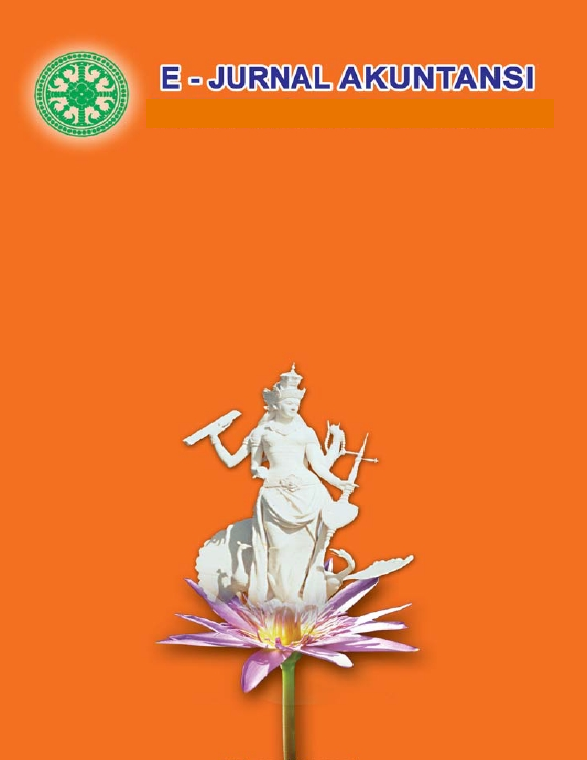Penerimaan Sistem Informasi Berbasis Teknologi oleh Karyawan PT. Merry’s Tour and Travel Menggunakan Aplikasi Quickbooks
Abstract
This research is intended to find out how the employee acceptance of the QuickBooks application system tested by Merry's Tour and Travel by using the Technology Acceptance Model (TAM). This study uses a population of all management and employees of Merry’s Tour and Travel. Determination of samples usingpurposive sampling techniques and the samples that met the criteria was 34 respondents. The data collection method uses a survey method with a questionnaire. Data were analyzed using Structural Equation Model (SEM), namely Partial Least Square (PLS). Based on the results of the analysis found that the variables of top management commitment, selft-efficacy, and perceived usefulness affect the acceptance of the QuickBooks information system at PT. Merry’s Tour and Travel. This indicates that the process of transition from manual systems to QuickBooks information systems cannot be fully explained by the Technology Acceptance Model.
Keywords: Perceived Ease Of Use; Perceived Usefulness; Attitude Toward Using; Behavioral Intension To Use; Technology Acceptancemodel (TAM).
Downloads
References
Aristo, J. (2017). Proyek dan Keterlibatan Pengguna terhadap Kesuksesan Implementasi Enterprise Resouce Planning. Jurnal Riset Manajemen Dan Bisnis (JRMB) Fakultas Ekonomi UNIAT\, 2(2), 147–154.
Bandura, A. (1994). Bandura Self-efficacy defined. Encyclopedia of Human Behavior. Retrieved from http://www.uky.edu/~eushe2/Bandura/BanEncy.html
Bangkara, R. P., & Mimba, N. P. S. H. (2016). Pengaruh Perceived Usefulness dan Perceived Ease of Use pada Minat Penggunaan Internet Banking dengan Attitude Toward Using Sebagai Variabel Intervening. Jurnal Akuntansi Universitas Udayana, 16(3), 2302–8556. https://doi.org/10.1088/0031-9155/47/24/301
Chin, J., & Lin, S. C. (2015). Investigating Users’ Perspectives in Building Energy Management System with an Extension of Technology Acceptance Model: A Case Study in Indonesian Manufacturing Companies. Procedia Computer Science, 72, 31–39. https://doi.org/10.1016/j.procs.2015.12.102
Chin, W. (1998). The partial least squares approach to structural equation modeling. Modern Methods for Business Research, 295(2), 295–336. https://doi.org/10.1016/j.aap.2008.12.010
Compeau, D., & Higgins, C. (1995). Application of social cognitive theory to training for computer skills. Information Systems Research, 6(2), 118–143. https://doi.org/10.1287/isre.6.2.118
Davis, F. (1989). Perceived Usefulness, Perceived Ease Of Use, And User Acceptance of Information Technology. MIS Quarterly, 13(3), 319. https://doi.org/10.2307/249008
Davis, F., Bagozzi, R., & Warshaw, P. (1989). User Acceptance Of Computer Technology: A Comparison Of Two Theoretical Models. Management Science, 35(8), 982. https://doi.org/10.2307/2632151
Ghozali, I. (2014). Partial Least Squares Konsep, Teknik dan Aplikasi Menggunakan Program Smartpls 3.0, (Ml), 290.
Hanggono, A. A., Handayani, S. R., & Susilo, H. (2015). Analisis atas Praktek TAM (Technology Acceptance Model) dalam Medukung Bisnis Online dengan Memanfaatkan Jejaring Sosial Instagram. Jurnal Administrasi Bisnis, 26(1), 1–9. https://doi.org/administrasibisnis.studentjournal.ub.ac.id.
Kartika. (2013). Technology Acceptence Model: Menguji Keefektivan Penerimaan Sistem Informasi Terpadu (Sister) di Lingkungan Universitas Jember. Jurnal Akuntansi Fakultas Ekonomi Universitas Jember, (November), 1–27.
Kartika, S. E. (2009). Analisis Proses Penerimaan Sistem Informasi iCons dengan Menggunakan Technology Acceptance Model pada Karyawan PT. Bank Negara Indonesia (PERSERO) TBK di Kota Semarang.
Latifah, & Afifah, A. N. (2013). Pengaruh Variabel Perceived Usefulness , Perceived Ease of Use , Perceived Enjoyment dan Attitude terhadap Pemanfaatan Visual Hotel Program pada Hotel-Hotel di Yogyakarta. Jurnal Riset Akuntansi & Komputerisasi Akuntansi, 4(1), 33–47.
Lewis, W., Agarwal, R., & Sambamurthy, V. (2003). Sources of influence on beliefs about information technology use: An empirical study of knowledge workers. , 657–678. MIS Quarterly, 27(4), 657–678. https://doi.org/10.1017/CBO9781107415324.004
Muntianah, S. T., Astuti, E. S., & Azizah, D. F. (2012). Pengaruh Minat Perilaku Terhadap Actual Use Teknologi Informasi dengan Pendekatan Technology Acceptance Model (TAM). Profit Universitas Brawijaya Malang, 6(1), 88–113.
Myristika, N. (2014). Analisis Penerimaan Mahasiswa terhadap Sistem Informasi Akademik Berbasis Web di Universitas Brawijaya dengan Menggunakan Technology Acceptance Model (TAM). Jurnal Ilmiah Mahasiswa FEB Universitas Brawijaya, 2.
Nugraha, A., & Laksito, H. (2014). Anteseden Penerimaan Teknologi Informasi dalam Profesi Audit Internal dengan Menggunakan Technology Acceptance Model (Studi Empiris pada Bank Perkreditan Rakyat di Jawa Tengah). Diponegoro Journal of Accounting, 3(2), 185–199.
Paramita, A. V., & Mudjahidin. (2014). Analisis Kemanfaatan dan Kemudahan Penggunaan Aplikasi Manajemen Surat dengan Pendekatan Technology Acceptance Model pada PT. XYZ Surabaya. Jurnal Teknik POMITS, 3(2), 216–221.
Primawati, A. (2015). Kajian Kesiapan dan Penerimaan Teknologi Aplikasi Google Documents untuk Penyelesaian Tugas Kelompok Siswa : Studi Kasus pada SMA Mardi Waluya Cibinong. Seminar Nasional Cendikiawan, 1–11.
Santoso, W., & Setiawan, D. (2017). Faktor-Faktor Yang Mempengaruhi Niat Penggunaan Approweb Oleh Account Representative Direktorat Jenderal Pajak. Ecojoin.Org, XXI(02), 232–252. Retrieved from http://www.ecojoin.org/index.php/EJA/article/view/197
Sarastini, N. P. E., & Suardikha, I. M. S. (2017). Pengaruh Pelatihan dan Pendidikan, Dukungan Manajemen Puncak dan Kemampuan Teknik Pemakai Sia Pada Kinerja Individual. E-Jurnal Akuntansi Universitas Udayana, 20(2), 1476–1503. https://doi.org/https://doi.org/10.24843/EJA.2017.v20.i02.p22
Sari, E. N. (2016). Analisis Faktor dalam Menggunakan Layanan E-BILL Dengan Pendekatan Technology Acceptance Model ( TAM ). Jurnal Ilmu Dan Riset Akuntansi, 5(April), 1–23.
Sidharta, I., & Rahmahwati, S. (2014). Pengukuran Persepsi Manfaat dan Persepsi Kemudahan Terhadap Sikap serta Dampaknya atas Penggunaan Ulang Online Shopping pada E-Commerce. Jurnal Computech & Bisnis, 8(2), 92–100.
Suardikha, I. M. S., T., S., Sukoharsono, E. G., & Purnomosidhi, B. (2012). Pengaruh Implementasi Budaya Tri Hita Karana Terhadap Penggunaan Sistem Informasi Akuntansi Dimediasi Keyakinan-Diri Atas Komputer, Keinovatifan Personal, Persepsi Kegunaan, Dan Persepsi Kemudahan Penggunaan Pada Bank Perkreditan Rakyat Di Bali. SNA XV Universitas Lambung Mangkurat Banjarmasin, 1–45.
Sulistyarini, S. (2012). Pengaruh Minat Individu terhadap Penggunaan Mobile Banking: Model Kombinasi Technology Acceptance Model (TAM) dan Theory of Planned Behavior (TPB). Jurnal Universitas Brawijaya, 1–20.
Sullivan, L. O., Power, V., Ortiz, J., & Italiano, I. (2017). User Centered Design and Usability of Bionic, (October). https://doi.org/10.1007/978-3-319-46669-9
Taylor, S., & Todd, P. A. (1995). Understanding Information Technology Usage: A Test of Competing Models. Information System Research, 6(2).
Utama, A. (2012). Pengaruh Faktor Institusional, Sosial Serta Individu terhadap Persepsi Manfaat Menggunakan Teknologi Informasi. Jurnal Manajemen Universitas Negeri Yogyakarta.
Utama, A., Wibowo, A., & Nurhadi. (2014). Pengaruh Faktor Individu Terhadap Keyakinan Manfaat Menggunakan Teknologi Informasi. Jurnal Economia Universitas Negeri Yogyakarta, 10(2), 177–186.

This work is licensed under a Creative Commons Attribution-ShareAlike 4.0 International License.

















